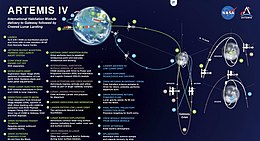


Summary of the Artemis 4 mission plan
| |
| Mission type | Gateway Assembly, lunar landing |
|---|---|
| Operator | NASA |
| Spacecraft properties | |
| Spacecraft | Orion (spacecraft) I-Hab |
| Manufacturer |
|
| Start of mission | |
| Launch date | September 2028 (planned)[1] |
| Rocket | SLS Block 1B (Orion) |
| Launch site | Kennedy Space Center, LC-39B |
| Contractor | NASA |
| End of mission | |
| Landing site | Pacific Ocean (planned) |
Artemis 4 (officially Artemis IV) is a planned mission of the NASA-led Artemis program. The mission will include the fourth use of a Space Launch System (SLS) launch vehicle, will send an Orion spacecraft with four astronauts to the Lunar Gateway space station, install a new module on the Gateway, and conduct the second lunar landing of the Artemis program.[2]
The mission will deliver and install the International Habitation Module (I-Hab) of the Lunar Gateway space station. I-Hab is being developed by the European Space Agency and the Japanese space agency JAXA. The mission will dock I-Hab to the first Gateway elements, the Power and Propulsion Element and Habitation and Logistics Outpost.
After docking, astronauts will board a Starship HLS (HLS) vehicle also docked to the station. They will descend to the lunar surface in the HLS lander for a multi-day site inspection.[3]
Artemis IV will be the first flight of the Block 1B version of the Space Launch System. For Block 1B the Interim Cryogenic Propulsion Stage used on SLS Block 1 will be replaced with the more powerful Exploration Upper Stage, increasing the rocket's trans-lunar injection capability from >27 t (60,000 lb), to >42 t (93,000 lb). This increased performance allows I-Hab to be launched together with the Orion spacecraft.
As of March 2023[update], Artemis IV is scheduled to launch no earlier than September 2028.[1]

| Position | Astronaut | |
|---|---|---|
| Commander | TBA spaceflight | |
| Pilot | TBA spaceflight | |
| Mission Specialist | TBA spaceflight | |
| Payload specialist | TBA spaceflight | |
The Space Launch System is a super-heavy-lift launcher used to launch the Orion spacecraft from Earth to a trans-lunar orbit. This will be the first Artemis mission to use an SLS Block 1B rocket with an advanced Exploration Upper Stage for four upcoming missions until the proposed Artemis 9, which will use SLS Block 2 with advanced boosters.[5]

Orion is the crew transport vehicle used by all Artemis missions. It comprises the Orion Crew Module and the European Service Module and will transport the crew from Earth to the Gateway orbit, dock to the Gateway, deliver the I-Hab module to the Gateway, and return them back to Earth.[6]

Gateway is a small modular space station to be established in Near-rectilinear halo orbit (NRHO) in late 2024.[7] The first two Gateway elements (Power and Propulsion Element and the Habitation and Logistics Outpost) will launch together aboard a SpaceX Falcon Heavy and spend a year spiraling out to the near-rectilinear halo orbit around the Moon prior to Artemis IV.[8]
Current Artemis IV mission plans call for use of the SpaceX Starship HLS Option B configuration to support the lunar landing and return to Gateway phase of the mission.[9]
The heavier total mass of the SLS Block 1B vehicle requires use of the Mobile Launcher-2 ground support equipment. Current development schedules and challenges experienced by the ML-2 contractor team in the design and delivery of the system have placed this GSE on the critical path from a schedule perspective.[10] Delays to ML-2 availability for use will delay launch of the SLS Block 1B variant. The NASA Office of Inspectior General (OIG) estimates the earliest that ML-2 will be available for Artemis IV is November 2026.[10]
|
| ||||||
|---|---|---|---|---|---|---|
| ||||||
| Missions |
| |||||
| Agencies |
| |||||
| Facilities |
| |||||
| Rockets |
| |||||
| Crewed spacecraft |
| |||||
| Robotic spacecraft |
| |||||
| ||||||
|
| |||||||
|---|---|---|---|---|---|---|---|
| Components |
| ||||||
| Programs |
| ||||||
| Launch vehicles |
| ||||||
| Precursors or Cancelled |
| ||||||
| Missions |
| ||||||
| |||||||
|
Lunar landing missions
| |||||||||||
|---|---|---|---|---|---|---|---|---|---|---|---|
| Active |
| ||||||||||
| Past |
| ||||||||||
| Failed |
| ||||||||||
| Planned |
| ||||||||||
| Proposed |
| ||||||||||
|
Future spaceflights
| |||||||||||||
|---|---|---|---|---|---|---|---|---|---|---|---|---|---|
| Crewed |
| ||||||||||||
| Uncrewed |
| ||||||||||||
| Recently launched |
| ||||||||||||
| |||||||||||||